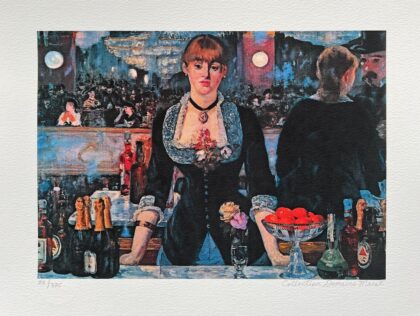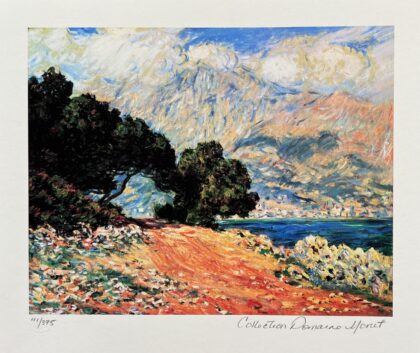This is a Claude Monet offset lithograph titled “VILLAS IN BORDIGHERA”. Year of original: 1884.
Paper Size: 16″ x 20″. Image Size: 11″ x 15″. Printed on thick quality paper stock.
Comes unframed. In mint condition! Beautiful rich colors!
Claude Oscar Monet was a French impressionist painter who brought the study of the transient effects of natural light to its most refined expression.
Monet was born on November 14, 1840, in Paris, but he spent most of his childhood in Le Havre. There, in his teens, he studied drawing; he also painted seascapes outside with the French painter Eugene Louis Boudin. By 1859 Monet had committed himself to a career as an artist and began to spend as much time in Paris as possible. During the 1860s he was associated with the preimpressionist painter Edouard Manet, and with other aspiring French painters destined to form the impressionist school—Camille Pissarro, Pierre Auguste Renoir, and Alfred Sisley.
Working outside, Monet painted simple landscapes and scenes of contemporary middle-class society, and he began to have some success at official exhibitions. As his style developed, however, Monet violated one traditional artistic convention after another in the interest of direct artistic expression. His experiments in rendering outdoor sunlight with a direct, sketchlike application of bright color became more and more daring, and he seemed to cut himself off from the possibility of a successful career as a conventional painter supported by the art establishment.
By the mid-1880s Monet, generally regarded as the leader of the impressionist school, had achieved significant recognition and financial security. Despite the boldness of his color and the extreme simplicity of his compositions, he was recognized as a master of meticulous observation, an artist who sacrificed neither the true complexities of nature nor the intensity of his own feelings. In 1890 he was able to purchase some property in the village of Giverny, not far from Paris, and there he began to construct a water garden (now open to the public)—a lily pond arched with a Japanese bridge and overhung with willows and clumps of bamboo.
Beginning in 1906, paintings of the pond and the water lilies occupied him for the remainder of his life; they hang in the Orangerie, Paris; the Art Institute of Chicago; and the Museum of Modern Art in New York City. Throughout these years he also worked on his other celebrated “series” paintings, groups of works representing the same subject—haystacks, poplars, Rouen Cathedral, the river Seine—seen in varying light, at different times of the day or seasons of the year. Despite failing eyesight, Monet continued to paint almost up to the time of his death, on December 5, 1926, at Giverny.




Reviews
There are no reviews yet.